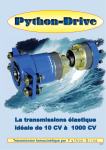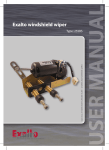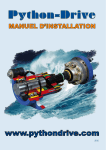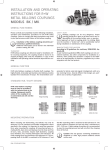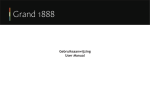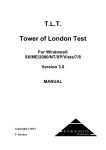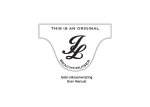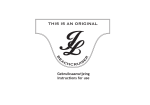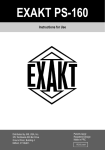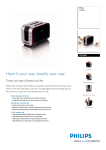Download Installation manual
Transcript
Python-Drive® INSTALLATION MANUAL Installation manual www.pythondrive.com 2010 1 Python-Drive® INSTALLATION MANUAL For units supplied by manufacturer after January 2007 2010 (c) For the models ranging from P30-R up to P1000-G May we take this opportunity to thank you for purchasing a Python-Drive flexible drive shaft assembly, your Python-Drive assembly is supplied complete with all the necessary bolts, screws, washers and nuts required. Please find below instructions designed to assist you during the assembly process. We recommend you read this manual before the actual process of installation. 1) Transmission adaptor flange. Check that the flange dimensions match your transmissions output flange. All fixing bolts and nuts use locking washers, please ensure they are used as directed below and are tightened to the correct torque settings. As indicated by drawing No. 1, Make sure that studs are screwed in with the short threaded part in the adaptor flange. Drawing 1 Fit and tighten the bolts and nuts using following torques (the tightening torques for the internal clamps can be found separately in chapter 3 of this manual) : M8 3/8”UNF M10 7/16” UNC M12 ½” UNC M14 M16 M18 3/4" UNC M20 M22 M24 1”UNC Nm 34 58 66 83 120 125 180 280 400 500 560 750 950 1040 Lb.ft. 25 43 49 61 88 91 132 205 295 368 413 406 700 765 We would recommend that all fixing bolts, nuts and threads are free of (dust)particles and grease, prior to assembly. 2) Mounting plate Due to the variations in hull design and material it is not possible for Python-Drive to supply mounting plates. We would ask you to remember, when designing a mounting plate it must be able to support the forces transmitted by the propeller. For plate dimensions refer to drawing No. 2A, 2B and 2C. The mounting plate should be at right angles to the prop shaft both vertically & horizontally, as indicated below with drawing No. 2. Prior to positioning the mounting plate please 90º ensure all distances have been correctly measured. The thrust bearing assembly should be mounted on the propeller side of the mounting plate, as indicated by drawing No. 3 Fixate the mounting plate under an angle of 90º compared to the propeller shaft as shown in drawing No. 2. 90º Drawing 2 Watch the video how the HBV Lock Systems perform compared to other products – Click here – The test proves the superiority of the HBV Lock Systems; even when all other locking systems fail, the HBV Lock washers keep the connection intact. Extreme shocks and especially vibrations are smoothly absorbed and have no influence on the tightening torque of the bolt/nut connection. The test is both simple as well as effective; a vibration in radial direction is unleashed on the bolt/nut connection while a load-cell continuously measures the tension (=tightening torque) 2 Python-Drive® INSTALLATION MANUAL Sizes of the various mounting plates: PD-R/B/K/M/S PD-T/Q/W/L A PD-G A B A B B D D C D E C G E C E F Drawing 2A Drawing 2C Drawing 2B A in mm B in mm C in mm D in mm E in mm P30-R / PD-R 143 106 53 25 NA P60-B / K / PD-B / K 157 120 60 30 NA P80-M / S / P110-S / PD-M / S 170 140 70 35 NA A in mm B in mm C in mm D in mm E in mm P110-T / P140-T / P200-T / PD-T / P200-Q / P501-Q / PD-Q 230 184 92 40 68 P200-W / P501-W / PD-W / P1000-L / PD-L 280 230 115 50 66 Drawing 2A Drawing 2B Drawing 2C A mm B mm C mm D mm E mm F mm G mm P1000-G / PD-G 436 250 125 >50 113 384 5 Arrangement bolts, nuts and thrust-blocks er ell op Pr Trust bearing e gin En er ell op Pr Mounting plate e gin En All models which carry the letter ‘R’, ‘B’ ‘K’, ‘M’, ‘S’ in the part No. Drawing 3 All models which carry the letter 'T', 'Q', 'W', ’L’, or 'G' in the part No. Please Note: The thrust bearing units of all models are electrically isolated i.e. there is no metal connection between the thrust bearing unit and the mounting plate. 3) Prop shaft to thrust bearing internal clamping: The clamping force is transmitted by contact pressure and friction between the mating surfaces, the condition of the contact surfaces and the correct tightening of the locking screws are essential. All contact surfaces including screw threads and screw head contact surfaces must be clean and slightly oiled. Do not use oils containing Molybdenum Disulphide! Once the ring clamp is in its correct position, tighten screws evenly in a diametrically opposite sequence by not more than half a turn per time tightening to the correct torque, as indicated by drawing No. 4. Recheck the tightening torque by going around the screws in the sequence described until no further movement is apparent. The assembly is then complete. 3 Python-Drive® INSTALLATION MANUAL The length of the prop shaft has to be determined as follows: Mounting-surface CV joint to end of propshaft (A) Total length of the prop shaft, which is pushed in the thrust bearing unit (B) P30-R / P60-B 14 - 20 mm P60-K 14 - 20 mm 90 - 96 mm P80-M / P80-S 16 - 20 mm 115 - 119 mm P110-S 16 - 20 mm 115 - 119 mm P110-T/P140-T 16 - 22 mm 123 - 129 mm P200-T/P200-Q 24 - 31 mm 144 - 151 mm P200-W 24 - 35 mm 180 - 191 mm P501-Q 32 - 39 mm 161 - 168 mm P501-W/P501-L 32 - 45 mm 180 - 193 mm P1000-L 32 - 45 mm 200 - 213 mm P1000-G 32 - 45 mm 60 - B Schroefas Propshaft A 66 mm depending on execution Drawing 4 Model Thread / torque P30-R / P60-B M6 - 14 Nm P60-K M6 - 17 Nm P80-M / P80-S / P110-S / P110-T / P140-T M6 - 17 Nm Thread / torque M8 - 41 Nm P200-T / P200-Q / P501-Q / P200-W / P501-Q M8 - 41 Nm M10 - 83 Nm P501-W / P501-L / P1000-L / P1000-G M8 - 41 Nm M10 - 83 Nm P1000-G M12 - 145 Nm In applications where a prop shaft is used with a relatively small shaft diameter and this in combination with a Python-Drive model with a relatively high maximum torque, the unit comes with an extra clamp unit, which is inserted at the rear of the hub of the thrust bearing unit. In such cases, the installation instructions of these clamps are supplied with the clamp. Depending on the actual maximum torque, such a situation is possible, when the shaft diameter is smaller than the minimum shaft diameter as given in the leaflet. In some cases of extremely high torque, again in combination with a relatively small shaft diameter, it is possible, that a 'Shrink Disc' will be added to the thrust bearing unit. The bolts of the ‘Shrink Disc’ are to be tightened with 30 Nm in the same manner as described for the internal clamps. Removal of internal clamp: Loosen the locking screws in a diametrically opposite sequence P30-R /P60-B : Remove all allen screws, then M8 bolts should be screwed in the pull out threads located under the silver-plated screws. The front ring of the clamp coupling can then be released (under normal conditions the front ring releases itself). See Fig. 1 & 2 Fig. 1 Fig. 2 P60-K / P80-M / P80-S / P110-S / P110-T / P140-T: Remove all allen screws and screw these into the release threads of the front ring, thus pressing the rear ring and release the clamp (see Fig. 3) Fig. 3 4 Python-Drive® INSTALLATION MANUAL P200-T up to P1000-G: remove all allen screws as previously described and screw them in the threaded bores in the front ring and release it (Fig. 4). Then screw the allen screws in the central flange and release the rear thrust ring (Fig. 5). Some of the units have a Shrink Disc coupling at the propeller-side of the thrust bearing unit, which is easily removed by simply loosening all the screws. For same applications an internal clamp coupling is used at the rear of the thrust bearing unit, which can be released in the same way as described with Fig. 3 Fig. 5 Fig. 4 4) Anti-vibration assembly: Drawing 5 The silent rubber blocks should be mounted as indicated in drawing No. 5. P30-R: silent rubber blocks should be compressed to 13 mm., P60-K to 16 mm and P80-S up to P1000-L to 15 mm. as indicated in drawing No. 5 Please note : should the mounting plate not be at right angles to the prop shaft, adjustment is possible by shimming between the rubber blocks and the mounting plate. Model PD-G / P1000-G has polyurethane thrust blocks,where the above described ‘compression’ does not apply, but shimming may be neccessary. A 5) Drive shaft lengths and angles: We recommend the flexible drive shaft installation lengths and angles are thoroughly checked. This procedure is important, due to the movement that may be inherent within the installation. Where engines are mounted on flexible mounts, there is always a tendency for the installation to move fore and aft, in addition to port and starboard. Allowing for plus or minus 2 mm. the net length of the flexible drive shafts of the models from P30-K to P140-T and for plus or minus 3 mm. for P200 and P501, can be taken from the drawings attached to this manual (these dimensions = L as indicated in drawing No. 6). For model P1000 also see these drawings (allowing for plus or minus 12 mm. ), see last pages of this manual. A simple way to determine the actual length is to measure both the longer side and the shorter side and to average them out. This must be the length of the flexible shaft you have chosen. If the location points are out in more than one plane, measure both planes as previously described and average the two sets of figures, as indicated by drawing No. 6 and No. 7 1 L 2 Drawing Drawing 6 6 Drawing 7 Drawing 7 The P30 up to the P110 drive shafts have coloured ‘O’ rings which hold the boot covers in place. The P140 has clamps which hold the boot cover of the CV joint in place, where one has a coloured tag to identify the net length of the CV drive shaft. The meaning of the colours is as follows: P30/60/80-145 mm WHITE standard length for P30-R and P60-B P30/60/80-165 mm BLUE standard length for P60-K P30/60/80-195 mm BLACK standard length for P80-S P110-180 mm YELLOW P110-225 mm RED GREEN standard length BLACK P140-180 mm BLACK P140-225 mm BLUE standard length 5 Python-Drive® INSTALLATION MANUAL Hub of thrust bearing unit Python-Drive Tip: Measuring of the length of Python-Drive CV drive shafts where models P200 and larger fit in recesses in the hub and the adaptor flange Adaptor flange for gearbox Net length (as shown in our leaflets and manuals) for standard versions of P200 and larger CV drive shafts Note: when the CV drive shaft is mounted, the length can only be checked by deducting the 'height' of the rim of the recess of both sides. Important; we recommend that the drive shaft “constant velocity” joint angles at either end of the shaft are installed correctly. Under no circumstance should a Python-Drive flexible drive shaft be installed at Zero angles (in line). To do so will greatly shorten the life of the CV joint, causing premature failure due to a loss of bearing efficiency/lubrication. A minimum of 1,5º per joint is recommended. The maximum angle of installation of the maximum angles and maximum propshaft RPM Python-Drive CV joint and the maximum P30 - P140 P200 – P1000 operating propshaft RPM is as indicated by chart No. 8 8º 0 - 1000 rpm. 7º 1500 rpm. 6º 2000 rpm. 5º 2500 rpm. 4º 3500 rpm. 3º 4500 rpm. 4º 1200 rpm. 3.5° 1500 rpm. 3° 1750 rpm. 2.5° 2250 rpm. 2° 3000 rpm. Chart No. 8 Ideally the CV joints should be mounted at approximately the same angle. If this is not possible ánd the difference between the angles of the front and rear CV joint would be greater than 5º, the CV-joints could become subject to abnormal loads, maybe resulting in premature wear. Drawing No. 9 shows the ideal set-up and drawing No.10 shows a less ideal set-up. Fig. 3 9 Drawing 6 Fig. 4 10 Drawing Python-Drive® INSTALLATION MANUAL CV Drive shaft assembly: Fit the shaft into place loosely, ensuring the threads of both sets of bolts are engaged as to the tightening procedure. Proceed to tighten the bolts in a diametrically opposite sequence to the correct torque, as indicated in the table under drawing No.1 Please note: All P1000 models require filling with grease, (see under 7 below), which is supplied in the parcel. 6) Python-Drive maintenance: • • • All thrust bearing units are maintenance-free as they have life-time lubrication. The following CV joints are supplied with lifetime lubrication and are therefore maintenance free: P30, P60, P80, P110, P140, P200, P501. All P1000 models require filling with grease prior to being installed in the boat. Grease is supplied as part of the kit, and should be filled flush with the top surface of the CV joints. Too much grease will automatically result in leakage causing the excess grease to be thrown out by the centrifugal force. Insufficient grease will cause premature failure due to lack of lubrication. When servicing, always ensure you use the correct specification grease to Orly TP210 NLGI 1 - 2 DIN KP2K-20. 7) Assembly checks: • • • • • • • • • • Ensure all washers are correctly located. Check studs, bolts and nuts are tightened to the correct torques (use a torque wrench!) Check required shaft lengths Check installation angles Check clamping surfaces are free of knocks or damage, which may prevent a face to face contact. Check for surface damages of the drive / thrust assembly Check the adjustment of the flexible engine mounting feet; as manufacturers use different instructions for their own make of mounts. Most manufacturers will allow you to pair wise adjust the load/compression of the left and right flexible engine mounting feet between 0 to 1 mm. Some manufacturers however won’t allow for any differences. Check both front and rear pairs. Prior to engine start up ensure the prop shaft rotates by hand and that all tools have been removed. It is essential that the engine, gearbox, torsional damper, propeller size and Python-Drive model are correctly matched, so that the engine can attain its rated speed appropriate to the relevant service classification without labouring. It is also important to ensure the torsional compatibility of the complete propulsion system from engine through to propeller, since disregarding this may result in gear noise. In addition, it may result in damage to the engine as well as to drive line components. The manufacturer of Python-Drive will provide all possible information and assistance to help find solutions to potential torsional problems. However, it is the ultimate responsibility of the person assembling the drive and driven equipment to ensure that they are torsionally compatible. 7 Python-Drive® Type P30-R 30 kgm 294 Nm Propeller shaft diam. 19 - 30 mm Maximum prop. thrust 4.3 kN Example use 50 HP / 3000 rpm with diesel engine 2.5:1 gearbox CV drive shaft optional lengths 145, 165 or 195mm. Maximum shaft torque Type P60-B 60 kgm 588 Nm Propeller shaft diam. 1.25" - 40 mm Maximum prop. thrust 5.7 kN Example use 70 HP / 2600 rpm with diesel engine 3:1 gearbox CV drive shaft optional lengths 145, 165 or 195mm. Maximum shaft torque Type P60-K 60 kgm 588 Nm Propeller shaft diam. 30 - 40 mm Maximum prop. thrust 5.7 kN Example use 70 HP / 2600 rpm with diesel engine 3:1 gearbox CV drive shaft optional lengths 145, 165 or 195mm. Maximum shaft torque Type P80-M 80 kgm 785 Nm Propeller shaft diam. 30 - 45 mm Maximum prop. thrust 8 kN Example use 105 HP / 3000 rpm with diesel engine 3:1 gearbox CV drive shaft optional lengths 145, 165 or 195mm. Maximum shaft torque Type P80-S 80 kgm 785 Nm Propeller shaft diam. 30 - 45 mm Maximum prop. thrust 12 kN Example use 130 HP / 2400 rpm with diesel engine 2:1 gearbox CV drive shaft optional lengths 145, 165 or 195mm. Maximum shaft torque 8 INSTALLATION MANUAL Python-Drive® Type INSTALLATION MANUAL P110-S 110 kgm 1.080 Nm Propeller shaft diam. 35 - 45 mm Maximum prop. thrust 12 kN Example use 135 HP / 2700 rpm with diesel engine 3:1 gearbox CV drive shaft optional lengths 180 or 225 mm. Maximum shaft torque Type P110-T 110 kgm 1.080 Nm Propeller shaft diam. 35 - 50 mm (2") Maximum prop. thrust 18 kN Example use 180 HP / 2400 rpm with diesel engine 2:1 gearbox CV drive shaft optional lengths 180 or 225 mm. Maximum shaft torque Type P140-T 140 kgm 1.370 Nm Propeller shaft diam. 40 - 55 mm Maximum prop. thrust 18 kN Example use 190 HP / 2500 rpm with diesel engine 2.5:1 gearbox CV drive shaft optional lengths 180 or 225 mm. Maximum shaft torque Type P200-T Propeller shaft diam. Maximum prop. thrust Example use with diesel engine 200 kgm 1.960 Nm 40 - 60 mm 18 kN 240 HP / 2300 rpm 2.5:1 gearbox Type P200-Q Maximum shaft torque Maximum shaft torque Propeller shaft diam. Maximum prop. thrust Example use with diesel engine 200 kgm 1.960 Nm 45 - 60 mm 22 kN 250 HP / 2800 rpm 3:1 gearbox 9 Python-Drive® Type P200-W Propeller shaft diam. Maximum prop. thrust Example use with diesel engine 200 kgm 1.960 Nm 50 - 60 mm 30 kN 275 HP / 2500 rpm 2.5:1 gearbox Type P501-Q Maximum shaft torque Maximum shaft torque INSTALLATION MANUAL 500 kgm 4.900 Nm 50 - 60 mm 22 kN 300 HP / 2000 rpm 3:1 gearbox Propeller shaft diam. Maximum prop. thrust Example use with diesel engine Recommended rpm Max. 1500 rpm PD-Q thrust unit CV drive shaft optional lengths 221 or 260 mm Type P501-W 500 kgm 4.900 Nm Propeller shaft diam. 50 - 80 mm Maximum prop. thrust 30 kN Example use 400 HP / 2200 rpm with diesel engine 3:1 gearbox CV drive shaft optional lengths 221 or 260 mm Maximum shaft torque Type Maximum shaft torque P501-L 500 kgm 4.900 Nm 50 - 80 mm 45 kN 500 HP / 2200 rpm 3:1 gearbox Propeller shaft diam. Maximum prop. thrust Example use with diesel engine Recommended rpm Max. 1500 rpm PD-L thrust unit CV drive shaft optional lengths 221 or 260 mm P1000-L Recommended rpm PD-L thrust unit Max.1500 rpm Maximum shaft torque 10 M16 222 140 66 662 ±12 520 ±12 77 245 280 340 Propeller shaft diam. Maximum prop. thrust Example use with diesel engine 1000 kgm 9.810 Nm 70 - 80 mm 45 kN 750 HP / 2000 rpm 3:1 gearbox Python-Drive Type 352 ±12 65 P1000-L Python-Drive® P1000-G Type Propeller shaft diam. Maximum prop. thrust Example use with diesel engine 1000 kgm 9.810 Nm 70 - 100 mm 60 kN 800 HP / 1900 rpm 3:1 gearbox Recommended rpm PD-G thrust unit Max. 1500 rpm Maximum shaft torque P1500-G Type Propeller shaft diam. Maximum prop. thrust Example use with diesel engine 1500 kgm 14.715 Nm 80 - 100 mm 60 kN 950 HP / 1900 rpm 3:1 gearbox Recommended rpm PD-G thrust unit Max. 1500 rpm Maximum shaft torque A. B. C. D. E. F. G. H. I. J. K. INSTALLATION MANUAL Bearing housing Thrust bearing Thrust rubbers Hub Internal clamp CV joint thrust bearing side Intermediate shaft Boot kit CV joint gearbox side Gearbox adaptor flange Propeller shaft A B G F H J I E K D C Above mentioned Python-Drive units are supplied complete with CV-drive shaft, thrust bearing unit, adaptor flanges for most regular 4”, 5”, 5.75” and 7.25” gearbox flanges, all bolts, nuts, thrust-rubbers and lock washers. Also included is an easy to read INSTALLATION MANUAL. 11












